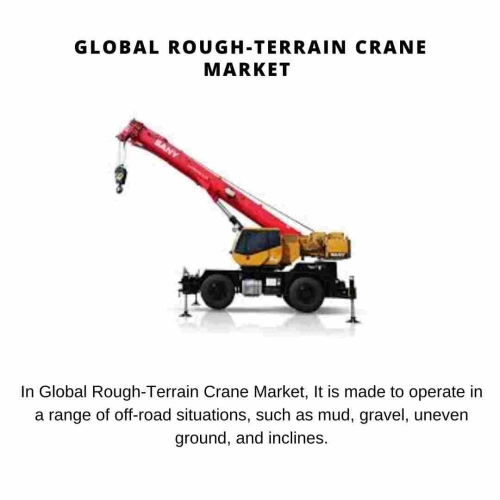
- Get in Touch with Us

Last Updated: Apr 25, 2025 | Study Period: 2024-2030
A mobile crane that is specifically made to work on rocky, uneven terrain is known as a rough-terrain crane. Large rubber tires, a high ground clearance, and a sturdy chassis all contribute to the vehicle's stability and mobility in difficult outdoor conditions.

A rough-terrain crane's main characteristics are as follows:
capability for all terrains: Rough-terrain cranes are made to operate in a range of off-road situations, such as mud, gravel, uneven ground, and inclines. The crane can move and function on uneven terrain, which would be challenging for other types of cranes, thanks to the enormous tires' traction and stability.
Compact size and mobility: Compared to larger types of cranes, rough-terrain cranes are small and very mobile. They are frequently utilized in industrial plants, oil refineries, building sites, and other places with restricted access or little available space. They can move through limited spaces and narrow tunnels thanks to their small size.
Telescopic boom: A telescopic boom on rough-terrain cranes can be hydraulically extended and retracted. The length of the boom varies from model to model, but it may generally reach considerable heights. The crane's telescopic boom enables it to carry out a variety of lifting operations, including positioning equipment, lifting heavy objects, and putting together structures.
Operator's Cab: With a rotating superstructure providing a 360-degree view, the operator's cab is situated on this device. As a result, the operator can see everything that is happening throughout the lifting process and its surroundings. Controls that allow for precise crane movement and placement are often present in the cab.
Rough-terrain cranes are available in a variety of sizes and lifting capacities. While larger models may raise loads up to 150 tons or more, smaller models may be able to lift roughly 20 to 30 tons. The crane's stability, counterweight, and boom length are only a few examples of the variables that affect lifting capacity.
Construction projects frequently involve the usage of rough-terrain cranes, particularly in regions with difficult terrain where other kinds of cranes would not be appropriate.
In outdoor construction sites, they are very helpful for moving and lifting huge objects like steel beams, concrete panels, and pre-fabricated parts. They are useful tools in the construction sector because of their adaptability, mobility, and ability to work in difficult terrain.

The Global Rough-Terrain Crane Market accounted for $XX Billion in 2023 and is anticipated to reach $XX Billion by 2030, registering a CAGR of XX% from 2024 to 2030.
Grove GRT8100-1, Manitowoc's newest rough-terrain crane, is now available. With a number of upgrades over the original GRT8100, this thrilling upgrade of the wildly popular GRT8100 will be offered.
Many of the improvements are the result of a new chassis that is similar to the chassis of the tried-and-true 120 t capacity GRT8120. A larger, broader cab with improved operating capabilities is also included, along with an updated engine and transmission package.
The GRT8100-1's excellent 360° load charts are carried over to its 100 t (100 USt) capacity model. It also keeps the same overall measurements, counterweight, and five-section, full-power MEGAFORM® boom that extends from 12 to 47 meters (39.2 to 154.3 feet).